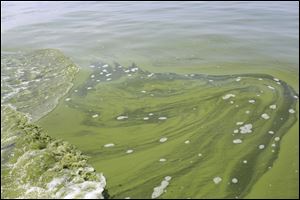
To the editor: Lots of money, but no results
7/11/2018
This Aug. 3, 2014 file photo shows Algae near the Toledo water intake crib, in Lake Erie, about 2.5 miles off the shore of Curtice, Ohio.
Ohio legislators recently passed Senate Bill 299 which authorizes an additional taxpayer-funded $36.1 million to fight toxic algal blooms in Lake Erie. Most of these funds will go to the Ohio Department of Agriculture. So much taxpayer money is being spent — but why no results?
What has changed since Lake Erie was cleaned up 20 years ago? Studies show that sewage treatment plant upgrade and improvements in industrial wastewater treatment have resulted in reaching phosphorus reduction goals. High phosphate detergents have been banned and Scotts has removed phosphorus from lawn care products.
I also found the number of concentrated animal feeding operations, or factory farms, has increased dramatically during the past 20 years, especially in the western Lake Erie basin. And manure is applied excessively over 70 percent of the time, resulting in the overabundance of phosphorus, which is the number one cause of toxic algae in the western basin.
Sen. Randy Gardner (R., Bowling Green) has voted for every bill supporting the CAFO industry over the years. This has resulted in the ODA becoming a one-stop shop for CAFOs and the increased deterioration of Lake Erie.
To quote a good friend: “If you are not outraged, you are not paying attention.”
VICKIE ASKINS
Cygnet
Editor’s note: Mrs. Askins is a member of advocates for a Clean Lake Erie.
Click here to submit a letter to the editor
Merge regional fire departments
I read the article about regional fire departments merging dispatch with Toledo. (July 8, “Dispatcher partnership is considered”). I think that is a good idea. Better yet, why not merge all the fire departments in Lucas County into one, calling it the Toledo-Lucas County regional fire department, and have the economies of scale to reduce costs. They all have reciprocal agreements to assist each other, so why have eight or 10 separate departments?
If Perrysburg wanted to join in, so much the better. Some have already merged such as Springfield and Spencer townships or Toledo and Ottawa Hills. Even better, why not a regional police force?
HAROLD KINKER
Holland